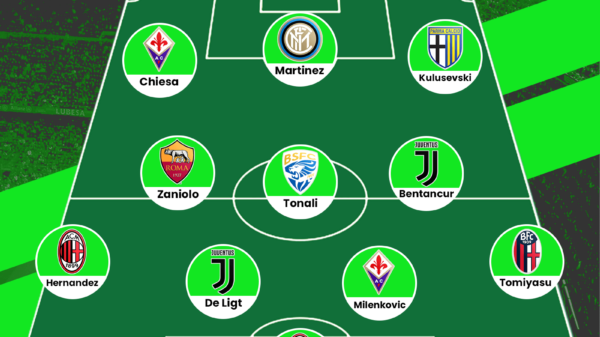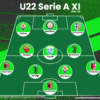Juventus played a typical European game, taking control of the proceedings from the start and never allowed Sevilla a sniff at goal. The Old Lady ran out comfortable 2-0 winners on the night, and signalled their serious intent in the competition. Sevilla, meanwhile, were never in the game, and were overrun by the Bianconeri from the first minute to the last.
Massimiliano Allegri did not repeat the mistakes that led to their loss to Napoli last weekend, and set his team up in the strongest way possible. Allegri showed his tactical nous in a European game once again, as he set his side up in a way that nullified the absence of a specialist right-back in the absence of the injured Stephan Lichtsteiner.
Juventus 2-0 Sevilla

Note: Sevilla left central defender is No.5 Kolodziejczak
Juventus: 1. Buffon, 15. Barzagli, 19. Bonucci, 3. Chiellini, 16. Cuadrado, 6. Khedira, 11. Hernanes, 10. Pogba, 33. Evra, 9. Morata, 21. Dybala
Sevilla: 1. Rico, 23. Coke, 17. Andreolli, 5. Kolodziejczak, 2. Tremoulinas, 22. Konoplyanka, 15. N’Zonzi, 4. Krychowiak, 7. Krohn-Dehli, 10. Reyes, 9. Gameiro
Centre-back Andre Barzagli started on the right side of defence, which on paper was a four-man back line, but Juve were lopsided in their 4-3-3 formation, with left-back Patrice Evra more often playing the role of a wing-back, while Barzagli rarely forayed with intent on the opposite flank, although his cross from the edge of the box on the right side assisted Alvaro Morata’s opener.
Leonardo Bonucci and Giorgio Chiellini formed the centre-back pairing, but it was more of a deep-lying playmaker role that Bonucci operated as, rather than a proper centre-back, as Chiellini, Hernanes and Barzagli sat ahead of the 28-year-old in possession phases. Juve’s retention of the ball in their own half, and patient build-up play owed much to Bonucci’s passing ability and vision, as he was also helped by a rather ineffectual Sevilla front line.
Paul Pogba and Sami Khedira manned the half-spaces on either side of Hernanes, who sat deep in midfield, and their energy and forward runs kept Sevilla from dictating proceedings. Khedira was more involved off the ball, and covered spaces and opened up spaces by drawing the Sevilla players towards him, while Pogba looked for the ball more often, and received passes more than double of what Khedira did.
Khedira was mainly used as a ball dump, and a wall in triangular combinations, as he recycled the ball quickly, whereas Pogba had greater creative responsibilities on his shoulders, and was often found on the left, where he combined well with compatriot Evra. Paulo Dybala had a free role, and dropped short on occasions while Morata ran the channels and played on the shoulders of the Sevilla back line, and even defensively helped Pogba and Evra on the left which completely wiped out the threat of Yevhen Konoplyanka.
Sevilla set up in a basic-looking 4-4-2 formation with a double pivot, and sat deep in a low defensive block in the first half, with their wide players, Konoplyanka and Krohn-Dehli, mostly engaged in defensive duties while the two holders, Grzegorz Krychowiak and Steven N’Zonzi, sat deep.
Krychowiak and N’Zonzi helped the two full-backs, Coke and Benoit Tremoulinas, widen the pitch in build-up phases by tucking in between the two centre-backs, Marco Andreolli and Timothee Kolodziejczak, but owing to their deep and compact shape, the two full-backs were almost always defending rather than motoring forward.
Krohn-Dehli started on the left, but roamed the breadth of the pitch, which left Sevilla with little to no attacking outlet on the left, as it was left to Tremoulinas alone to instigate attacks down that side, and the Frenchman was mostly found defending against the dynamic and direct Juan Cuadrado. Cuadrado troubled Sevilla all night long, starting from his outside right position and dribbling with confidence.
It was Cuadrado’s threat that forced Sevilla into a mistake leading to the first Juve goal, and the Colombian never stopped running with the ball till the final whistle. Sevilla’s front line was formed by Jose Antonio Reyes and Kevin Gameiro, and Gameiro had to feed on scraps mostly, while captain Reyes tried to make play by dropping short on numerous occasions, which left Gameiro isolated against the strong Juve defence.
Juventus’ Switches of Play
It seemed as if Sevilla were initially intent on aggressive man-oriented pressing inside their defensive third, as evident from the screengrab below from the 1st minute. As Morata is hounded on the edge of the box, Pogba — who made a run from the left half space into the box — is unmanned inside the 18-yard box, and this leads to an early chance for Juventus.
After this early chance, Sevilla were undone by Juve’s quick switches of play which made it impossible for the Spanish side to maintain the tempo of their initial plan, and were forced to make ball-oriented indents. Juve made life difficult for Sevilla’s wide defenders, and basically took them out of the game.
Cuadrado on the outside right was an excellent outlet for the likes of Pogba to switch play which in turn forced the Sevilla line to make horizontal shifts, which perhaps was one of the reasons why Sevilla sat in a very low block. Sevilla’s low block meant Gameiro up front was hopelessly isolated, which allowed Juve to comfortably and patiently build up play.
Juve’s switches were also helped by poor indents from Sevilla, as Cuadrado had plenty time and space to make his direct runs, and given his prowess in 1v1 situations, Sevilla were made to play directly into Juve’s hands. Pogba, who was the most active Juve midfielder and one of the biggest threats, constantly pinged balls down the right to Cuadrado after drawing Sevilla players towards the left during combinations with Evra.
The following screenshot shows exactly what Juve tried to do in the initial stages of the game. An accurate diagonal switch from Pogba to Cuadrado on the wide right makes it difficult for the Sevilla players to make a ball-oriented shift. This leaves open spaces for Khedira to make his runs into the box, as well as isolates Cuadrado, who is very strong in 1v1 situations.
Sevilla’s Deep Set-Up
It was perhaps Unai Emery’s plan to soak Juventus’ pressure by sitting in a low block, pressing them aggressively near the box and then instigating counter attacks. But both Emery and his side were undone from the off, and their strategy instead allowed Juve to patiently build up from the back whilst offering space aplenty around the edge of the box for the likes of Hernanes, whose three shots all came inside the opening 20 minutes.
Sevilla’s problems were evident when they were found wanting during attacking transitions. In the following scenario from the 19th minute, Krychowiak wins the ball inside the Juve half, but has little to no forward passing option and as a result he passes sideways to his right, and allows Juve to regroup in midfield. Juve quickly regain possession and start an attack of their own.
Juventus’ Off-The Ball Patterns
Juve were disciplined in defensive phases of play, and worked hard to regain possession. Although they did not employ a consistent pressing scheme, which was barely required given Sevilla rarely put together a proper passing, attacking move, the likes of Khedira and Morata pressed well in their respective zones whilst the rest maintained their positions well during transition play.
The intent was to allow as little central space and passing lanes as possible, and all the three midfielders played their part in successfully repelling Sevilla moves. In the following scenario from the 28th minute, Morata closes in on right-back Coke, who is devoid of passing options owing to the Juve players covering the Sevilla players in their vicinity.
Another scenario from a minute later, as we see Khedira doing his bit to not allow Krohn-Dehli to find Tremoulinas on the left. In this situation, the Dane is in a poor body shape to seek out Tremoulinas, and hence is forced to pass the ball back to Kolodziejczak. Khedira, who offers precious little on the ball and is not the most creative, is one of the best at manipulating space and making off-the-ball movements that indirectly help his team.
Juve’s pressing scheme and their positional discipline meant Sevilla found it difficult to initiate attacking play from central zones. This led to lots of backpasses to goalkeeper Sergio Rico which also afforded Juve plenty time to regroup and manage the match. The following diagram compares the passes received by the two goalkeepers, and shows how Sevilla were subjected more pressure in their first phase of attack.
Other Patterns in the Game
Certain patterns emerged in the second half, as Pogba became a marked man, while the ever-elusive Dybala evaded his markers by dropping short and receiving the ball in deeper areas than expected of a forward. A look at Dybala’s heat map from the game puts into perspective why he is regarded as one of the best young attackers in the game. Apart from his obvious technical ability, Dybala runs and runs and pops up in places you wouldn’t normally associate a forward with.
Krychowiak and N’Zonzi were tasked with keeping Pogba quiet in the second half, whichever player found himself close to the Frenchman. Pogba, though, was unfazed by that and frequently made inside movements from his starting position on the left half space. Marking Pogba came with risks for Sevilla, as it left holes in front of the back line when he evaded Krychowiak or N’Zonzi (as shown below).
As the game wore on with the score at 1-0, Sevilla made a midfield change and brought on Vicente Iborra in N’Zonzi’s place. That change brought about a new dimension to Sevilla’s patterns, and allowed them to force the issue given Juve only held a one goal lead at that point. But Juve were barely troubled, and this was mostly because they kept Konoplyanka in check.
Reyes, another of Sevilla’s potent attacking weapons, faded as the minutes passed, and even sat as the deepest midfielder until he was subbed off in the 79th minute. Reyes failed to influence much, and looked visibly tired as he came off. In the following screenshot from the 68th minute, Reyes and Krohn-Dehli are seen exchanging passes from the base of midfield.
Conclusion
Juventus changed their shape in the dying minutes, but by then it was a case of job well done for Allegri’s men as they executed their plan to perfection. Cuadrado was a constant threat, but he was equally helped by the defensive solidity behind him. Meanwhile on the other flank, it was all Pogba and Evra, which forced the normally attack-minded Konoplyanka into a defensive brief.
Sevilla lacked ideas going forward, and were hindered greatly by their deep lines of defence and midfield. The decision to play two forwards instead of another midfielder might look like a poor one in hindsight, but Juventus are a different beast in Europe. With two wins in two to start the campaign, the Old Lady are clearly on their way to atoning for the disappointment of last season’s final.
Written by Abhijit Bharali
- Analysing Belgium’s tactical approach at the 2018 World Cup - June 17, 2018
- Tactical Analysis : Sevilla 0-0 Villarreal: Villarreal’s off-the-ball discipline denies Sevilla - February 8, 2017
- Indian Super League: Indian Team of the Tournament (League Phase) - December 12, 2016






































































